Managing with Males"
Part ONE - Should I or Shouldn't I?
Part TWO - Introductions and Behavior
Part THREE - Habitat Essentials
Part FOUR - Unplanned Drama
PART ONE
All Piggies Need a Pal
Guinea pigs all need a friend. Single guinea pig homes are discouraged, as guinea pigs are a social, herd animal, and are happier and healthier in pairs or small groups. Non-breeding pairs, that is. Please don't contribute to the huge pet overpopulation problem, which includes guinea pigs. Odds are roughly 50/50 that you may have a female pair or a male pair. Knowing the differences between them in behavior and care and what to expect can go a long way to avoiding common and sometimes costly pitfalls over time!
In the world of guinea pigs, certain things defy common sense, so it's good to arm yourself with more info should any of these discussed possibilities come your way.
If you are lucky enough to have a neutered male/female pair, you can consider that the same as having two females. Spayed females are pretty rare. There are only a few pockets around the country that have a few spayed females circulating. Spaying is a more invasive, expensive, and riskier surgery than neutering males. In addition, it doesn't slow the male down at all on his pestering her. Although, with a non-breeding pair of either type (spayed female or neutered male), the female typically rules the roost in the social hierarchy pecking order and puts the male in his place soon enough and when she wants to. Kind of like in real life, right ladies?
Sunshine and Roses with Two Males?
It's very true that guinea pig personalities are quite individual, just like people. There is a mix of nature/nurture influences that combine to make each animal unique. But, we can do a bit of stereotyping between males and females.
While reading this info about males, if you start to feel a bit cautionary about them, the flip side is that males "can" be a tad more fun and entertaining as compared to females. Bottomline, they are worth any possible extra effort or considerations you may need to make.
The same advice here about males can be helpful if you have one of those rarer DIVA female situations as well.
Two is Company
The odds of having two males live together happily into adulthood are very high -- about 85% to 90%, but there is a slim chance that it just won’t work out, so it’s important to know how to give them their best chance for successful bonding. Two males will get along the vast majority of the time. And males should have a friend, so it’s important to understand how to successfully pair them up. The odds of having two males live together happily into adulthood are very high -- about 85% to 90%, but there is a slim chance that it just won’t work out, and it wasn’t a good pairing after all. If you have two adult males 6-12 months old or more, and who’ve been living together longer than 6 months, then you can consider them bonded.
But if you have two young males, don't make the mistake of thinking that they are bonded because they are getting along great now or because they are. It's a common assumption and one of the most common pitfalls with managing males. Read on!
Three can be a Crowd
 If you have two males now, you may think that since they get along, maybe you'll add a third. That’s a decision a fair number of people come to regret. If you have to, you have to, but know the risks going in and be prepared to have to separate them if needed. Also, be prepared for a second big cage and possibly needing to get a 4th male so that odd guy out isn’t single in the long run. If you have to separate but can't fit two cages, you will need one very big cage to humanely divide the it providing an appropriate amount of space on each side. That means having a Jumbo C&C cage (2×6 grids = 7.5 feet long) preferably with lofts on each end as well.
If you have two males now, you may think that since they get along, maybe you'll add a third. That’s a decision a fair number of people come to regret. If you have to, you have to, but know the risks going in and be prepared to have to separate them if needed. Also, be prepared for a second big cage and possibly needing to get a 4th male so that odd guy out isn’t single in the long run. If you have to separate but can't fit two cages, you will need one very big cage to humanely divide the it providing an appropriate amount of space on each side. That means having a Jumbo C&C cage (2×6 grids = 7.5 feet long) preferably with lofts on each end as well.
The odds flip with THREE males getting along into adulthood. It’s more like about a 15-20% chance it will work out in the long run. Sadly, more often than not, it won’t. Don’t be fooled if they are still young (babies through a few months old) as everything is always hunky dory when they're young perhaps with some rumble-strutting, chasing, and mounting — but no serious fighting. That is, until they reach adolescence.
You also risk breaking the bond between your original pair.
If you do add a third guinea pig, review the tips listed below to help mitigate aggression as they vie for dominance.
The Brotherhood Botherhood
It’s a common assumption that if they are ‘brothers’ they’ll grow up together and get along great -- and it can seem that way in the beginning. The thing with litter-mates is they go through their hormonal changes at the same time and they are usually about the same size. It can definitely work out for some, but it can be a significant challenge for many. Their 'teenage' years seem to be most prevalent in the 5 to 9 month age.
The Social Hierarchy
One of them is or will be the boss. When looking to pair up a male, how they behaved on their own or with a different guinea pig is not necessarily how it will play out in a new pairing. The low pig on the totem pole may decide he’s had enough and try to assert his dominance with a new one or new group — especially adolescents or young adults (5-12 months old range). The safest bet is to look for a size differential between two males so that there is an obvious “I’m the boss and you’re not” disparity that can more quickly settle the issue.
Their Most Obvious “TELL”
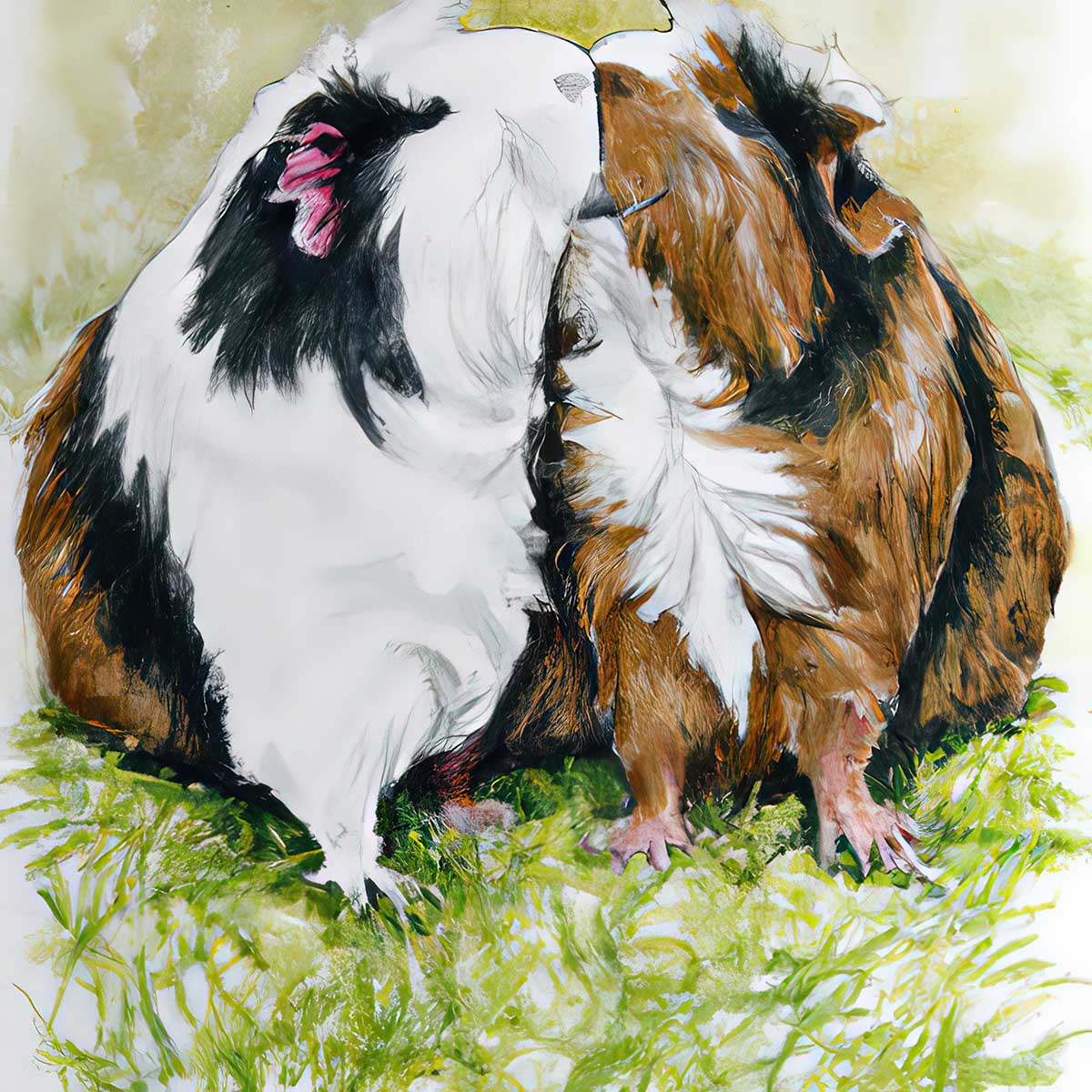 Have you seen that behavior they do when they are nose-to-nose and their heads keep going up higher in the air? It’s rather a competition and a challenge. The ALPHA pig stays high, the one willing to be #2 will put his head under the head of the alpha pig.
Have you seen that behavior they do when they are nose-to-nose and their heads keep going up higher in the air? It’s rather a competition and a challenge. The ALPHA pig stays high, the one willing to be #2 will put his head under the head of the alpha pig.
So, you can see which pig is willing to yield and allow the other to be the alpha pig. But even with that 'permission' so to speak, sometimes, it's just not enough of a capitulation for a dominant male. Maybe they think, "well, that was too easy, I want more pestering fun." It can happen. That's when you have to be prepared for the posturing and behaviors.
Adapting to Change takes TIME
Big changes are stressful on guinea pigs. They need months -- not days or weeks -- to settle in enough to “let their hair down” so to speak.
Big changes include:
- Being adopted
- Moving
- New guinea pig friend
- Separation from a guinea pig friend or family
- New cage
- Big fights with cage-mates
Guinea pigs coming from a pet store are highly stressed with massive changes they’ve had to endure. Patience is important.
Even when initial introductions seem to go well, you tend not to see their ‘real’ behavior until they’ve moved passed their concern about more changes coming. It can take a couple of months for the ‘bickering to begin’ because they were just sharing mutual panic about their circumstances in a ‘truce of survival.’
PART TWO
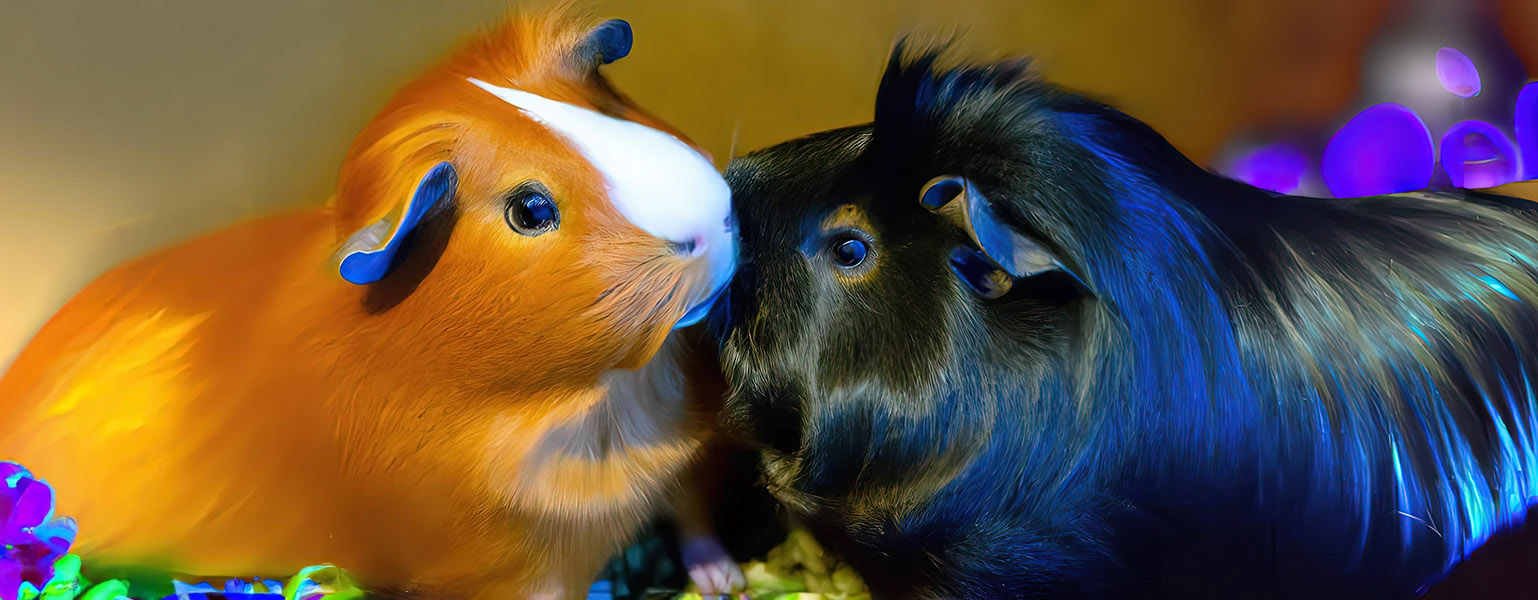
Introductions
First, make sure YOU have confirmed all GENDERS
Before you physically start combining your guinea pigs, be 100% positive of their sex. Never, ever trust anyone else's sexing statements. ALWAYS verify this yourself. Everyone has made a mistake in the past on sexing. Vets, rescues, shelter staff -- EVERYONE -- but far, far, far more prone to mistakes than most -- pet store staff! Don't pay the price for someone else's mistake.
Is your new pig healthy?
Introductions should only be done after it's been deemed that both pigs are healthy and can't pass parasites or infections to the other. Any pig from a pet store or unknown source should be quarantined for 2 weeks before you introduce him to your current one. Know that many pet store pigs are frequently ill, have mites, or may be missexed or pregnant. This is just one of the reasons why private adoptions are the safest way to go.
Guinea pigs are a prey animal and do their best to hide their symptoms when they are ill as it's a survival instinct when in a herd in the wild. As a result, they need time to settle down from the stress of a move so that you can better evaluate possible symptoms. Any infections they may be harboring need time to surface. A new guinea pig needs to be kept isolated from your current pig or herd to make sure there are no health issues.
Quarantine
Quarantine done right means SEPARATE ROOMS for two weeks. The goal is to prevent the spread of mites or illnesses like URIs or other contagious organisms. Keeping the pigs next to each other in a separated cage is not an effective method of quarantine.
If you just cannot accommodate proper quarantine, make very sure your new pig is healthy -- no scratching, good coat, no raspy breathing, healthy-looking poops, and good appetite.
Don't just plunk a new pig in with your existing pig
The general idea is to introduce guinea pigs in a neutral area for a while and let them discover and get acquainted with each other outside of a cage. A little shared stress can be a bit bonding. A long couch works great or an enclosed pen on the floor. This way, the resident pig's space isn't being immediately invaded by a stranger, and there isn't familiar territory to defend.
Preparations
- Towel and/or Dustpan
Have both a towel and a dustpan at the ready (best to have both handy) to help separate piggies in case of fighting.
- New cage, new bedding OR a very clean existing cage
Clean and rearrange bedding and hideys in an existing cage. You want the current resident to not lay claim to his usual haunts. You need to rearrange the cage as radically as you can. The cage needs to be ready to receive your guinea pigs after introductions are complete.
- Get a large bath towel or two
To cover the couch or floor temporarily
- Hay/Food
Have some hay and maybe a little fresh food for the center of the meeting area. - Stinky!
Just be prepared for a bit of musky male scent. Upon occasion, it can be quite 'odiferous' during introductions and you may need to open a window! It doesn't last long, so don't worry about it. It's normal.
The Dating Game Process
- Put a pile of hay in the center of the meeting area.
Make the pile big enough so that there won't be any quibbling over a small amount. - Each person holding a pig, sits at opposite ends of the couch or floor. Make sure the towels are between you and there is a good amount of space (it helps to have a big couch!). Floor works, too. Keep kids quiet and out of reach. No other distractions. This is absolutely NOT play or petting time for the kids.
- Let the pigs find each other on their own time.
You may need to nudge them in the right direction. Have another towel handy to toss on the pigs if you need to separate them.
- Let the games begin!
More often than not, pet owners want to break up guinea pigs exhibiting normal dominant behavior. Everyone looks worried and asks, "Is that normal?" Be prepared to answer the question, "Mommy, what are they doing?" - How long and what next?
Usually, the first 15 minutes is just getting acclimated to the new surroundings and the idea that there is another guinea pig there. It's the next 15 to 30 minutes that can get interesting. The nice thing about being on the couch is it makes it easy for them to run to you when they get uncomfortable. But, keep your interactions and interference to an absolute minimum.
Some guinea pigs will get along just great. Some will decide on peaceful co-existence right from the beginning. Some will act like long lost buddies or lovers! But, most will go through the standard dominance dance of getting to know each other and trying to figure out who is going to be the boss of who. They must and will decide this for themselves. It may not be now, but it will get decided.
When to separate them?
When serious blood is drawn or a wound is inflicted. Some nipping or minor biting can be quite normal. Even little tufts of hair in the mouth can be normal. Review the behaviors below to help guide you on how it's going.
“Rule of THREES” when doing Introductions
When pairing up guinea pigs, especially males, use the “Rule of Threes” as your guideline for setting your expectations on their behavior.
- First 3 MINUTES
If they haven’t launched into immediate attacks, reared back on their haunches, displayed lunges, or major fighting — we’re talking rolling ball of fur fighting — then WHOOHOO, GREAT, carry on with the dating game.
- First 3 HOURS
There is usually a LOT of chasing and mounting from many directions, teeth chattering, rumble-strutting (butt swaying back and forth while rumbling), scent marking (phew, open the windows, ha ha ha!), etc., ALL of which are NORMAL when introducing males. Nipping and biting are also normal. STOP any lunges or major biting (dustpan inserted between them or towel thrown over them) — NEVER put your hands in the middle of a boar fight.
- First 3 DAYS
The chasing, mounting, and rumble-strutting will still be pretty intense. Keep an eye on them, but get some sleep without worrying too much.
- First 3 WEEKS
It will settle down some, but behavior can still be a bit feisty for a while as they start to get used to their new digs together. Give them time to figure out a routine and come to the very, very slow realization that the humans who control their lives aren’t going to keep making more upsetting changes.
- First 3 MONTHS
Over this time, things will settle down as they continue to accept their new reality and sort it out amongst themselves on how their relationship is going to work. By the end of three months, things will have settled down into a workable routine.
Be BRAVE!
You need to let the animals be animals. Too many people separate males because a little bickering or nipping is too upsetting to watch, but ultimately this just prolongs introductions and increases time spent alone.
START in a PROPERLY SIZED CAGE
BEFORE YOU TRY THIS AT HOME, first, make sure you are giving the males a big enough cage. We'll cover that in more detail in Part Three, but keep in mind that a 2x4 grid cage (2.5'x5') is the MINIMUM cage size, and a 2x5 grid cage (2.5'x6.5') is the RECOMMENDED cage size for two males. Single Midwest cages are too small. A 2x3 grid cage (30"x44") is also too small. A cage that is too small encourages bickering -- they just don't have enough room to run around and put enough space between them when they need it -- physically, visually, and odiferously.
Try NOT to SEPARATE
Every time you separate them for dominance behavior, it will just have to begin all over again when you put them back together. You need to let them work it out -- as long as they aren't trying to kill each other. That's why you need to know how to interpret their behaviors.
Don't panic too soon. You have to give them time to do their dance and sort it out.
Male Posturing and Behavior
What to look for and when to be concerned. Level One behaviors are to be expected, Level Two is “on alert”, and Level Three behaviors often need quick intervention. Familiarize yourself with these behaviors beforehand and be ready to provide distraction or separate quickly, if needed.
LEVEL ONE
Safe, non-combative, dominance behavior. Leave them to it.
- Rumblestrutting
The word rather says it all. You'll know it when you see it. :) - Butt sniffing
- Butt nudging
- Chasing
- Butt dragging
They are leaving their scent. They identify each other with scent as well as marking their territory. - Sniffing
A guinea pig's sense of smell is VERY GOOD -- about 25 times greater than ours! They identify each other by smell -- and you, too. This is why good ventilation in clean cages is very important for guinea pigs.

- Mounting
Any which way: rear mount, head mount, side mount, flying leap mount! It can be a very 'exciting' time for them. - Nose face-offs
Higher in the air wins, one must lower their nose to be subservient to the other.
- Teeth chattering (a little)
- Raised hackles
Hair is raised on the back of the neck and along the spine. - Light Nipping
Occasional nips
LEVEL TWO
Posturing for possible attack, battle for dominance is escalating. Be wary, but you still need to let them work it out.
- Teeth chattering
Sign of anger, aggression, warning - Nips
Light bites, may result in little tufts of fur in their teeth - Wide yawn
In these circumstances, this is no yawn. They are showing their teeth. Of course, you have to interpret this in context, because sometimes they are yawning. But, when in the dominance dance, they aren’t tired; they aren't yawning. It's a sign of dominance. It’s like a tough guy puffing up his chest to look more threatening.
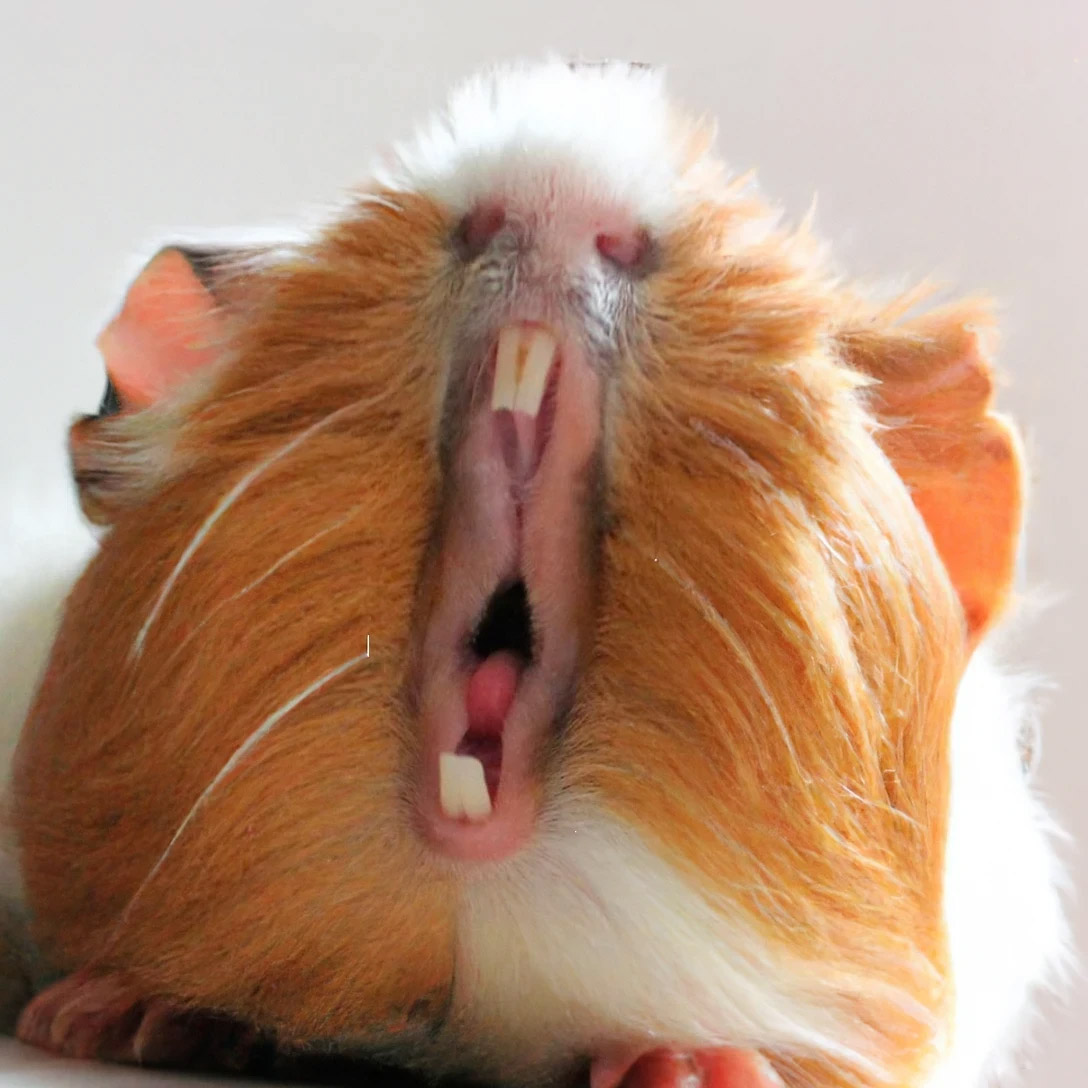
- Snorting
Sounds like a strong puff or hiss
These behaviors may sound serious and they should be monitored CLOSELY, BUT do NOT separate the pigs exhibiting these behaviors, yet. This is when the average pet owner loses it and pulls the pig out. Most of the time, this behavior will continue for a while until one backs down.
LEVEL THREE
Fighting with intent to harm
- Bite attacks
These are no longer warning nips, they are lunges with intent to harm. If blood is drawn, it's usually time to separate. Any serious wound, of course, requires separation. - Combination of raised hackles, loud and angry teeth chattering, rumblestrutting in place
With the head staying in one position while facing the other guinea pig doing the same thing.
Usually a signal of a biting attack. But they may back down before they engage. - Both pigs rear up on their haunches, face to face.
This is a clear, brief signal of their intent to launch full attacks at each other. Separate immediately if possible before the attack -- it's likely imminent.
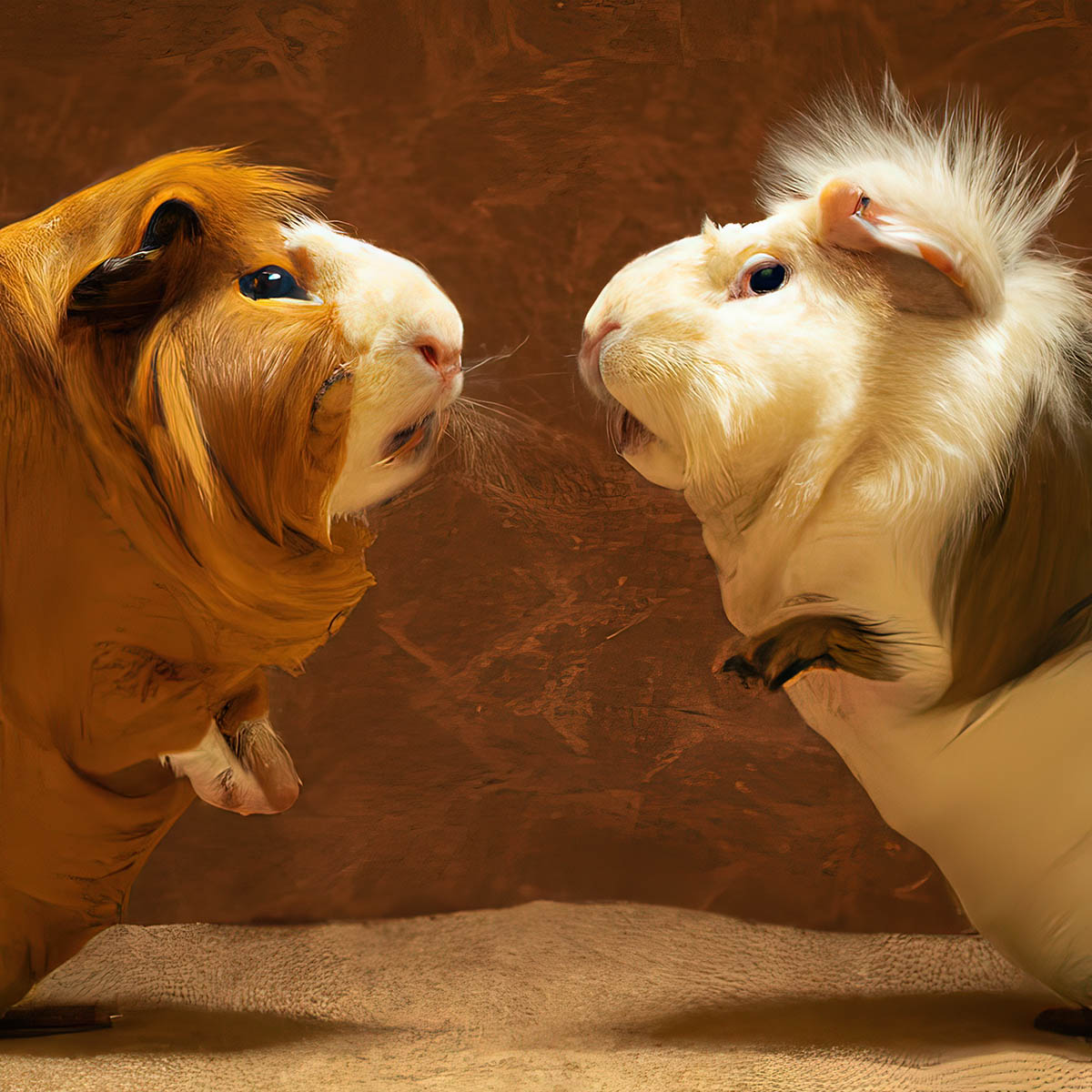
- Full battle
The pigs are locked together in a vicious ball of fur. This is very serious. Separate immediately, but be careful. Throw a towel over them and use a dustpan or something other than your hand to separate them. Unintended bites from their very sharp incisors can cause serious damage.
After Introductions . . . Follow-up!
Skin Check-up
No matter whether things went well or not, one thing you need to do after introductions, and sometimes on a regular basis if you know your pigs are bickering at all, is the FINGER CRAWL MEDICAL INSPECTION.
This is actually the FUN part, because you have your pig out in your lap for a pet and a check-over. With your pig on your lap gently but thoroughly run your fingertips lightly through their hair feeling their skin, all over their body, like a light full-body massage, checking for any bumps that indicate scabs from nips or bites. If you find a scab, inspect it for infection. These bites can get infected and they are easy to miss because their teeth are so sharp that the bites wounds are small, but potentially a bit deep. If the scab looks like a normal, flat scab, it's fine and will heal. If it's raised or red or has that icky infected smell, then you may need to remove the scab, flush the infection if it's doable for you, and apply just a tad of over-the-counter antibiotic ointment or even just plain coconut oil. This is minor stuff and easily doable by you. You should be able to tell if something is more serious that might require a vet visit. But, catching any infection early makes life easier.
Boar Glue Removal
The birds and bees of boars!
ONCE in a WHILE, when you’ve got boars you’ll be wondering about some weird stuff that gets in other boar’s hair that is really hard to get off. It’s the semen from another boar. It can get stuck on fleece or almost anywhere. It seems stronger than super glue and you frequently have to cut it out. It's partly why guinea pigs are prolific breeders. Once a male impregnates a female, it creates a hardened plug that keeps his sperm in place and helps prevent any competitor's sperm from getting through. Interesting, right?
It can be particularly noticeable after a feisty introduction session.
How did it go?
GOOD RESULT
Things went well enough and it's been a couple of hours at least. Now, it's okay to put them both in the cage together. There will still likely be a lot of action going on, but refer back to the Rule of Threes!
MIXED RESULTS
Separate; wait; try again in a couple of weeks; hope for the best. Separation should be in a 2x6 Jumbo C&C cage with a Wall of Silence Cage Divider -- initially withOUT the Coroplast wall of the divider installed. Let them see each other through the grids. If there is non-stop biting and pulling at the grid wires, then you need to add the Coroplast wall to it -- which is exactly why it's called the "Wall of Silence!" It stops the incessant aggression of one pig trying to get to the other.
POOR RESULTS
Blood drawn, possible wounds, serious fighting. Sometimes, it just won't work out. You can try a separation, let things calm down. But, the worse the fight, the longer you need to separate them to give them time to let it go. They tend to hang on to the bad feelings for quite a while though, so you need to have patience. It might take months, not weeks, before you should try re-introducing them.
PART THREE
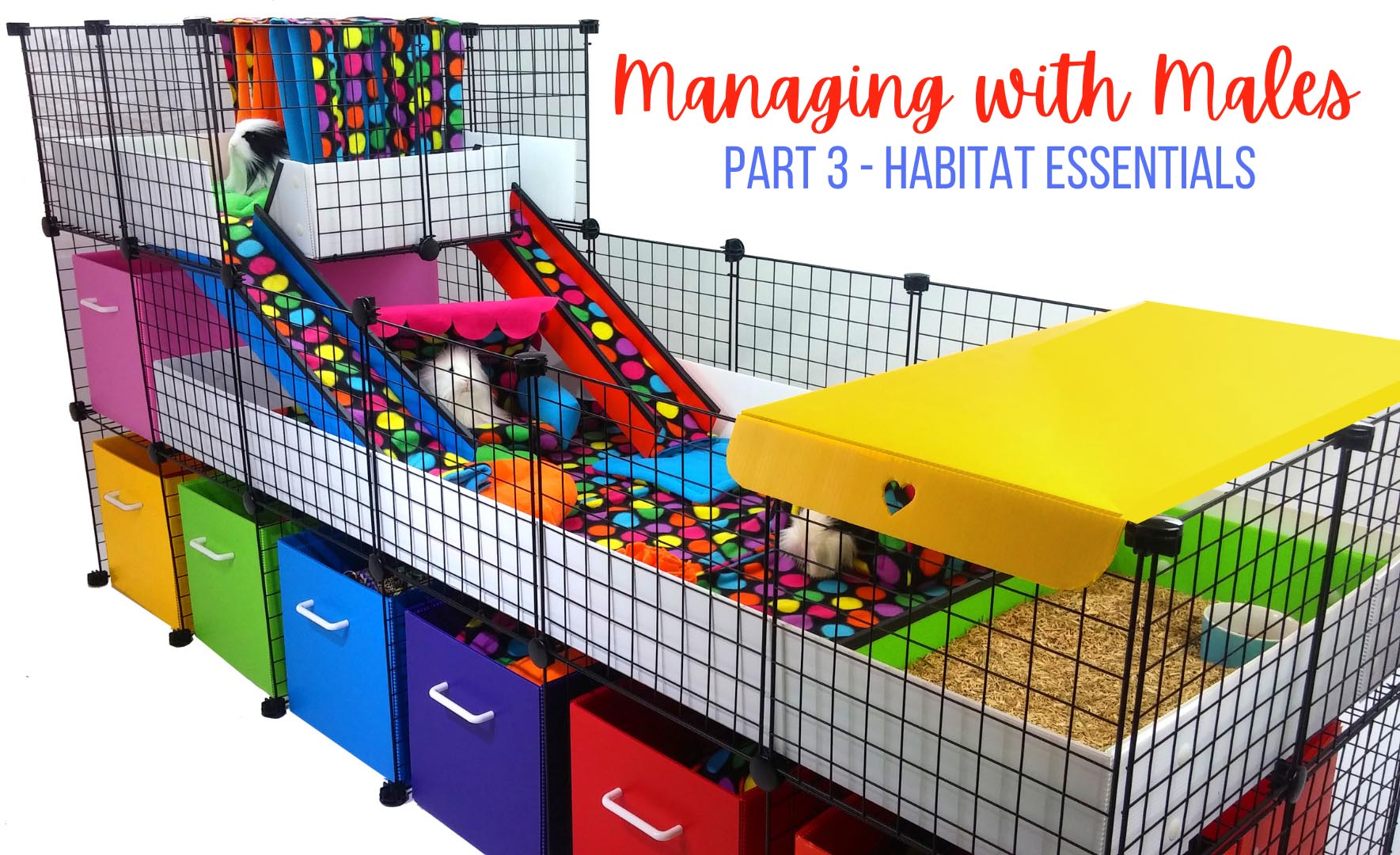
The Cage, What's In it, and How things are Arranged
Successful Male Relationships Depend on these 3 Aspects of their Environment
#1 - Cage SIZE
The #1 key to peaceful co-existence between males is having a properly-sized cage. Males need more space than females because, as you would expect, they tend to be more territorial.
Imagine throwing two active teenage boys together -- each with a very strong sense of smell -- in a small bedroom and expecting them to live together peacefully -- forever. That's what it's like in a too-small cage.
The smallest humanely-sized cage for any guinea pig is 7.5 square feet (not 7.2) or a 2x3 grid-sized cage. The recommended size for one guinea pig is the large, 2x4 grid-sized cage. The recommended cage size for a pair of males is the XL 2x5 grid-sized cage.
#2 - Cage COMPONENTS & ACCESSORIES
Your choice of hideys and hangouts can help or hinder a peaceful lifestyle for your guinea pig.
#3 - Cage FENG SHUI -- How things are Arranged
How you arrange things in your cage can also go a long way towards helping to keep the peace between two males in the long-term.
Cage SIZE
Ideally, two males need a 2x5 grid-sized cage where the grids are 14 inches square. That's a 2.5' x 6.5' cage. That's pretty big! And bigger is always better at that.
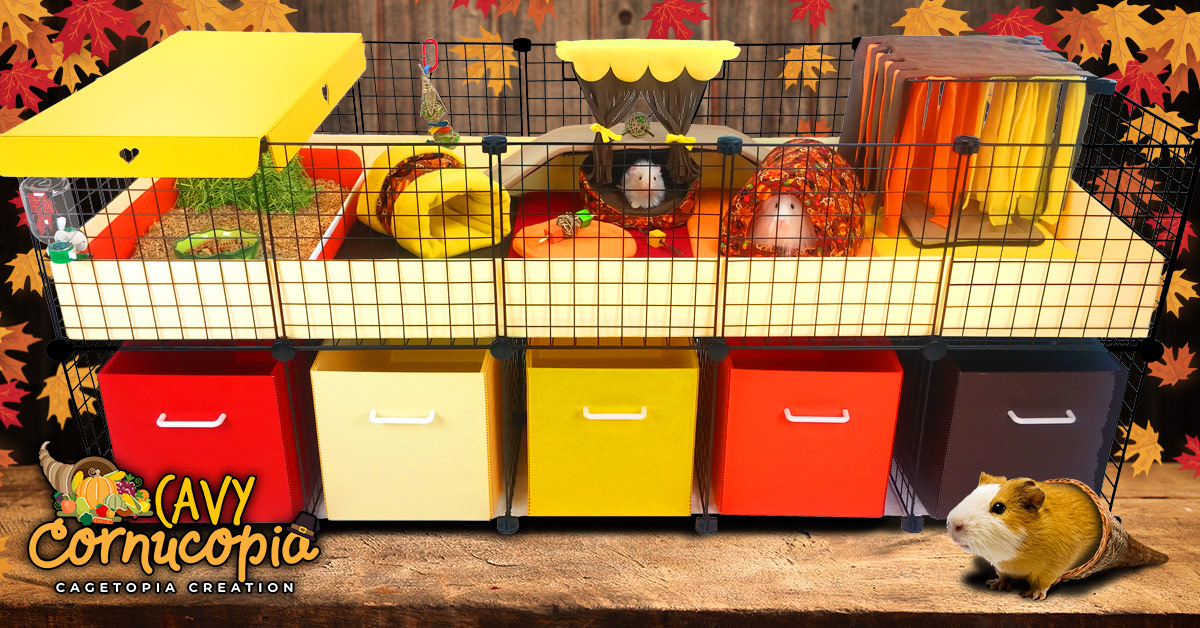
The "What ifs?"
"What if you end up needing to divide the cage due to squabbling? Each guinea pig needs the equivalent of a SMALL C&C cage for a humane living area. Plus, it allows the pigs to share a common wall for staying socially happy.
Cage Separation: TIME OUT or PERMANENT?
If you need to separate your two males, it's always a good idea to consider it temporary, as investing in a cage expansion, remodel, or addition, and all the extras that go with it, is not the ideal scenario for anyone -- not you, not the pigs, not your level of effort, and not the additional expense.
So, it's in your best interests to give them some time apart, with the hope that things will work out later after the dust has settled.
You can compromise on space for a short time in hopes that the pair will get along in the not too distant future. But, for a long-term separation with a common grid wall, you need a Jumbo, 2x6 grid-length cage, one way or the other. There are few ways to accomplish that as we'll go over.
Do your research so that you can decide now what the best cage will be for you in the long run. If you have the space and budget, you should consider investing in a big cage from the beginning which provides the best chance of getting along and while having options to separate in the future without too much drama. This is why I bring this up now rather than later -- when you need to figure out what to do if things aren't working out right away.
The BIGGER the CAGE, the EASIER it is to keep CLEAN!
While it can be a bit overwhelming to decide to go all in on a great cage for your boars, the upside is that it's much easier to maintain a big cage than a smaller one. Less work, more fun. Much, much easier to manage than stacked cages, which we'll address later as well.
The WALL of SILENCE
To divide a cage (hopefully one that is 2x6 grids) you can use our aptly-named Wall of Silence Cage Divider.
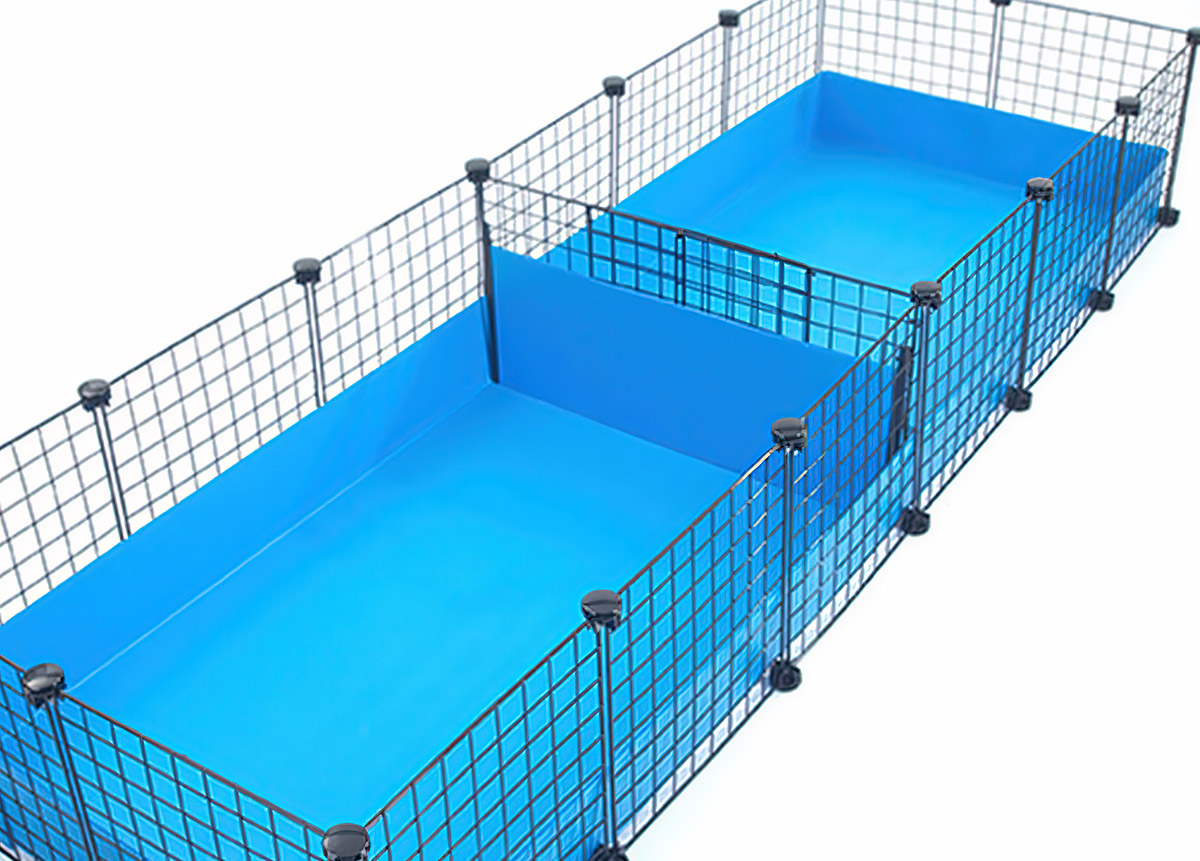
Remove or Add Coro as needed
You should try initially leaving out the Coroplast piece. But, if one or both of them start chewing on the grid wires incessantly in the hopes to 'get to' the other pig, then you can remedy that by inserting the Coroplast part of the divider as well. If there is general peace, it's much better to leave the Coro off so that they can interact with each other.
To LOFT or not to LOFT?
Absolutely add a second level for males! There are multiple compelling reasons to add an upper level of some flavor for a pair of males. Assuming you've got the minimum space needed on the bottom, adding a loft is a great way to go.
- Visual distance from cage mate
Out of sight, out of mind. - Sniff distance from cage mate
Out of overpowering smell zone - Physical distance from cage mate
- HEALTHIER exercise for males
Keeping their butt muscles more toned up over time (going up and down a ramp) may help prevent impaction (constipation) later in life. - MORE exercise for males
Burns more energy running around, makes them more tired, less energy for picking on each other. - Life ENRICHMENT
An upper level of some flavor gives your pig more to do in their daily life in a cage.
KEY for cage structure and accessories for males: Entrance & Exit!
Make sure your cage structure and most things inside the cage have an entrance and exit. This helps ensure that one pig can't trap another or claim and guard a space in the cage.
Choose an Upper level with TWO RAMPS
Consider choosing an upper level that has two ramps if you can. That allows guinea pigs to do their full-circle zoomies, and allows an escape if one is blocking the way.
- Full circle zoomies!
Fun to watch and better for pigs as they can keep moving in a continuous line and flow. They have to come to a full stop and turn if they only have one ramp up to a loft. - No Bully Blocking!
No pig can plop their body at the top of or at the foot of a ramp. Piggies are funny in their respect of the social hierarchy. (Cute side story here.) A non-fighting, but annoying, behavior from a dominant male or female is to just park themselves at the top or bottom of a ramp which will definitely stop any other pig. They won't jump the blockade. It's a territorial move, although non-violent. Having two ramps allows access for all pigs.
Add a Lookout Lounge
Our Lookout Lounge is super popular with almost all guinea pigs. It has TWO ramps, so is great for males. It's at half-height, so even older, arthritic or plump, lazy pigs can easily navigate the incline. Pigs are very well protected there from bullying by another pig. They feel quite secure there. It's a great pig hang-out that's fun for you, too, as you can usually see your pigs better there.
Choose Tunnels over "PigLoos"
Those plastic igloo-shaped hideys are pretty much the worst thing for males. The tunnel is too easily 'guarded' and affords for surprise attacks to noses. Instead go with tunnels or Magic Muffs -- soft tunnels and very comfy and popular with the pigs.
Choose Fleece Forests
Fleece Forests are one of the best things for males as they can hide, but they can't be trapped in them. Pigs can run through them or settle in for a quiet private nap. They don't get as dirty as other items because they don't lay on the strips, so it's win/win all the way around.
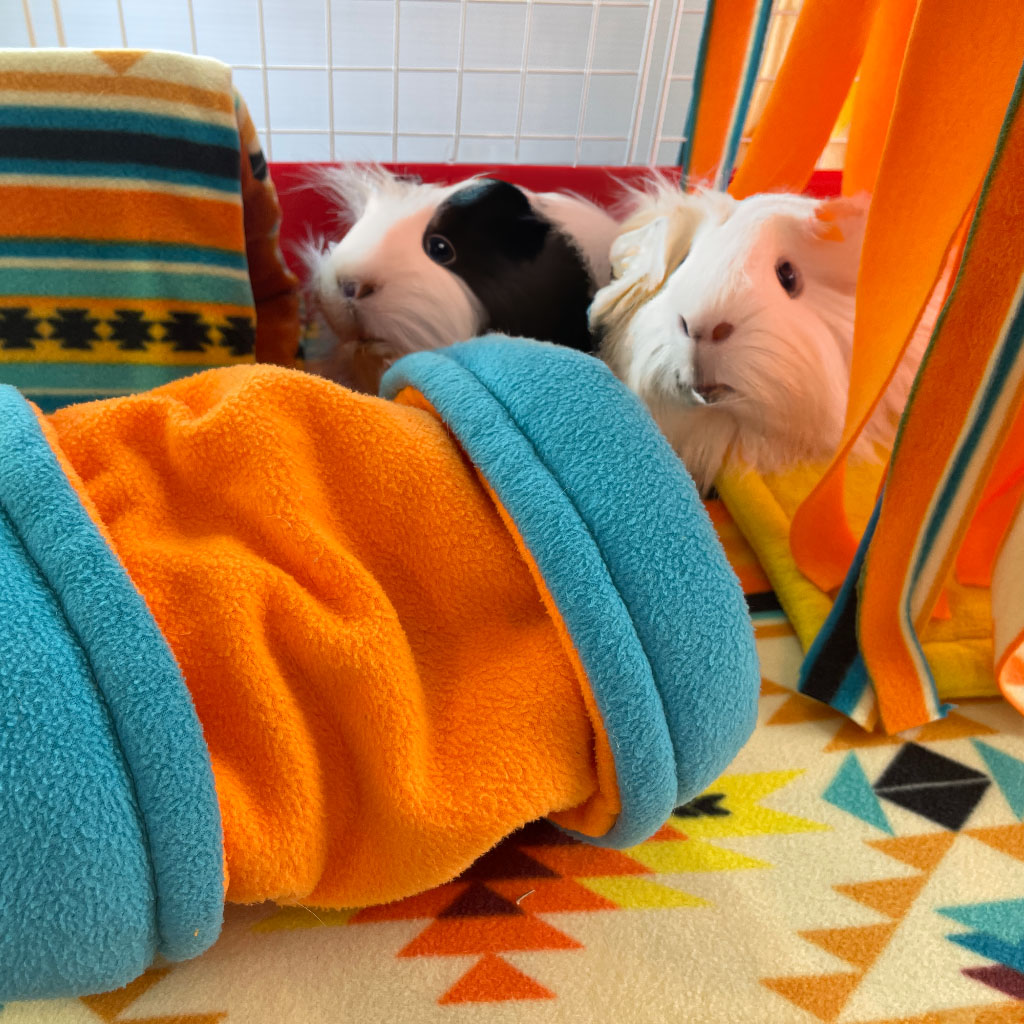
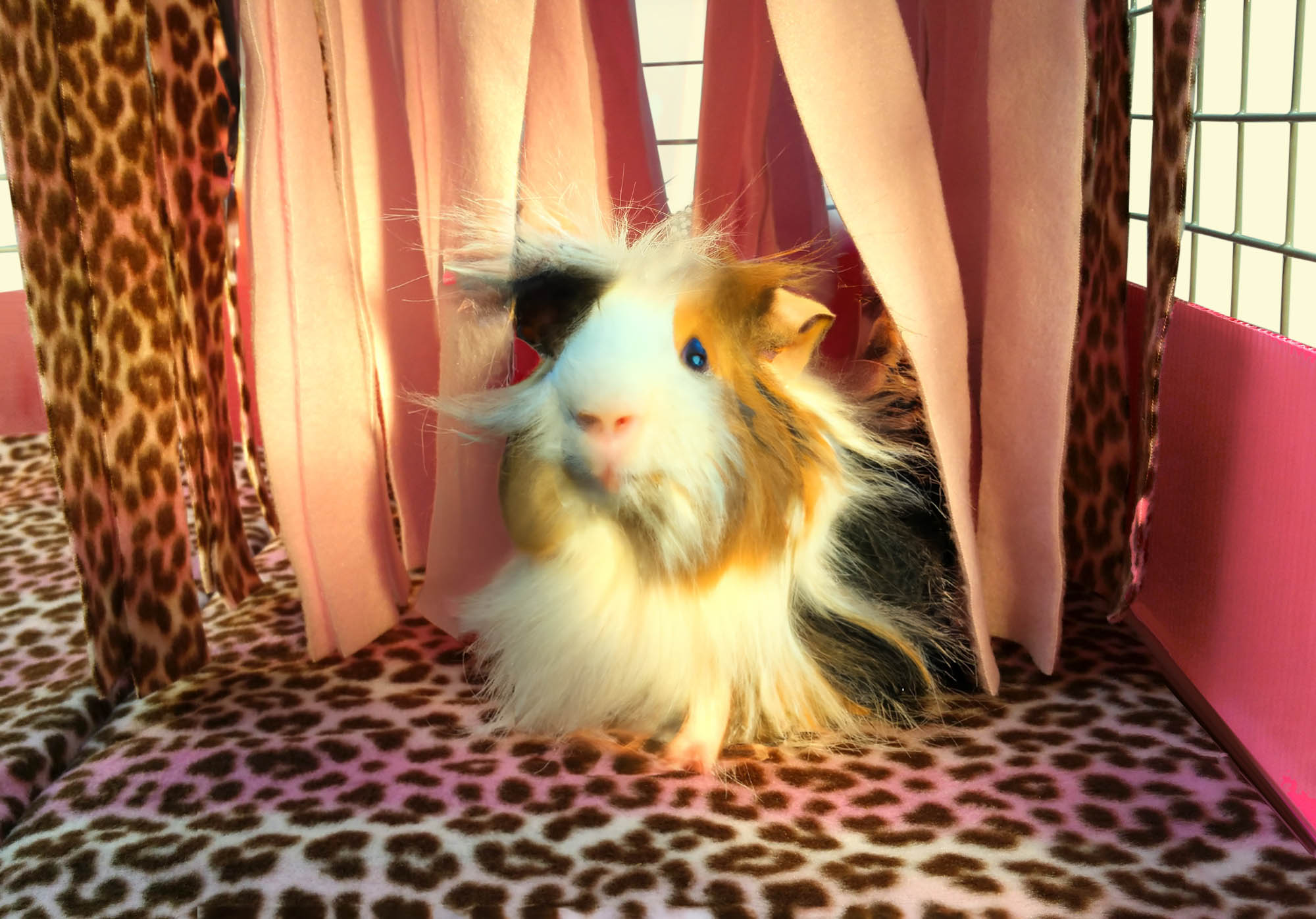
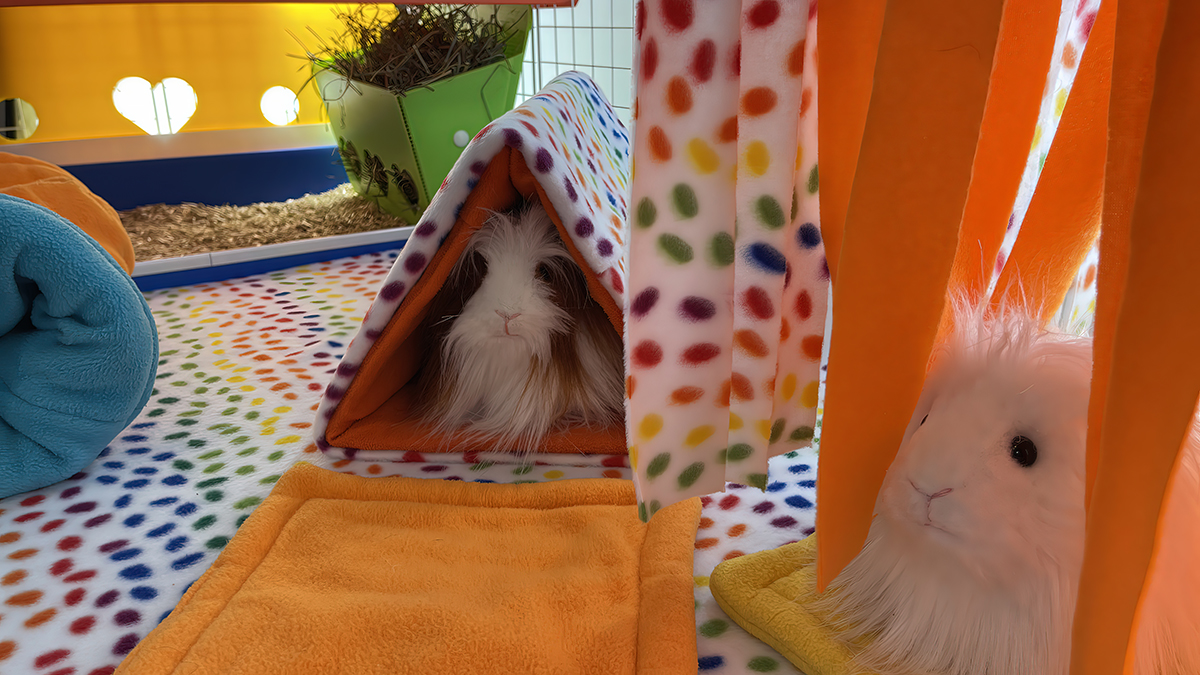
Number of HIDEYS? P+1
The number of hideys you need in a cage is P+1, where P = the number of pigs in the cage. 2 pigs need 3 hideys. That helps keep the peace on "mine, not yours." There is always a third, neutral hang-out to be had.
And it's another reason why you need a good sized-cage. The hideys need space, too, along with allowing enough room for the pigs to get around them.
Cage FENG SHUI
Try to resist the urge to put hideys up against a wall or corner (except for Fleece Forests, of course). Move hideys and tunnels away from walls. Give your pigs a habitat that allows them to explore and rearrange their furniture -- which they dearly love to do! So, let them. Think in terms of figure eights. Let your guinea pigs be able to run figure eights around items in your cage, if at all possible.
Sizes, Lofts, and Saving Space
There is the ideal and then there is what your resources dictate -- space, money, time, energy, commitment, and more. There are so many different circumstances that people have to juggle with differing priorities on any given day. Life is messy. So, here are some considerations on choices. We'll go more into what makes sense in different circumstances in the next installment.
The overall winner for space, cleanability, enrichment and long-term cost is the "Leap Into Spring" Creative Setup. Two sets of double ramps. And the LOOKOUT LOUNGE is a particularly great selection for males. A Large Cage (2x4 grids) with a Wide Loft Offset (2x2 grids), is better choice than a single-level XL Cage (2x5 grids).
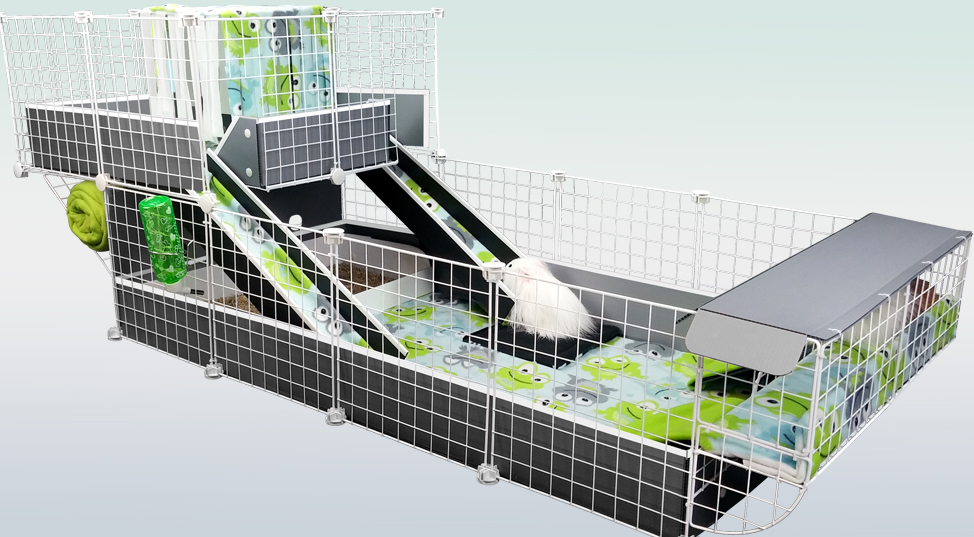
This cage can sit on top of a 2x4 grid Large stand OR a 30"x60" table if you have the additional wall space for the overhang portions.
A Porch Patio is another good alternative with two ramps.
MORE Creative Cage Suggestions for Males!
These creative setups are all recommended for a pair of males. They are all big enough and generally have a two-ramp feature if there is an upper level.
Go big or go home?
Check out this amazing cage setup for a herd of males that needed separating in our Customer Stories blog.
Kristie's Stacked Super Cage for Males!
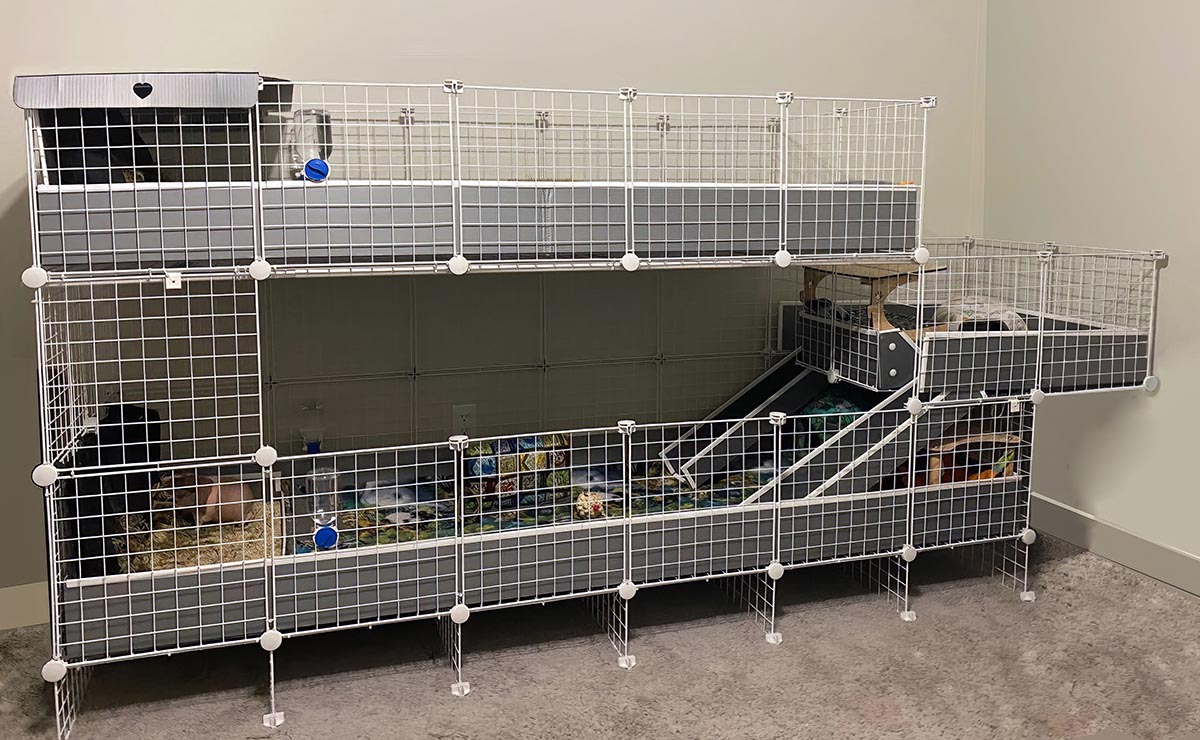
PART FOUR
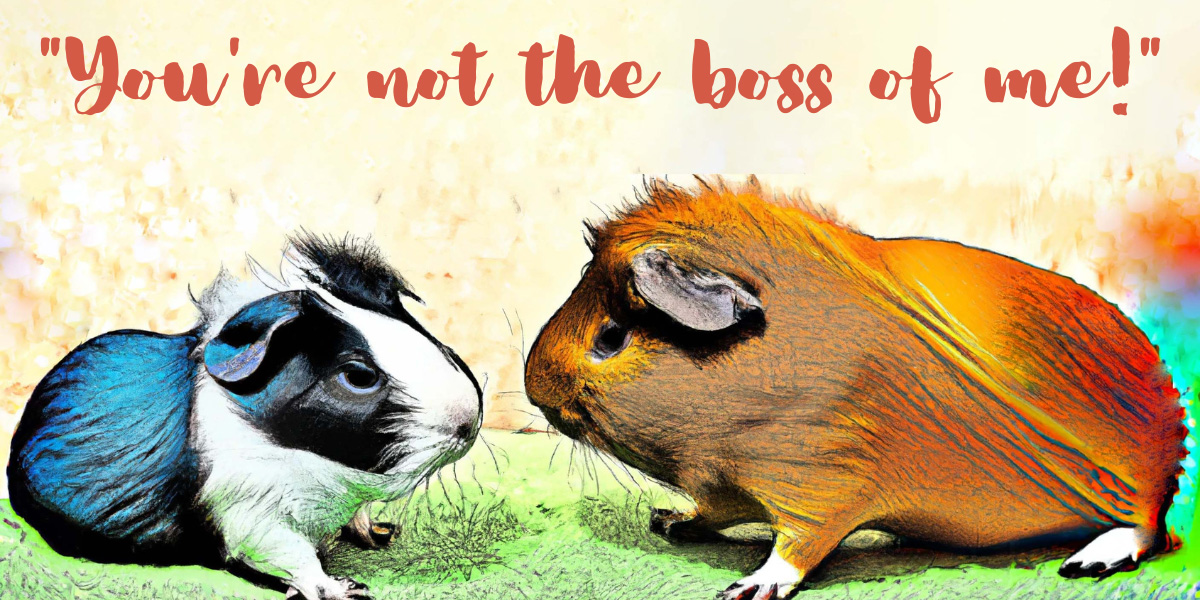
What are your options when trouble rears up?
Can this relationship be saved?
Let's hope so. You've reviewed the behavior noted above and have decided that intervention is required.
If the squabbling is minor and you think there is hope they can work it out, there are a number of things you can consider to mitigate the behavior. These efforts might be enough to keep the peace. You want to prevent separation if possible, as that will likely entail more effort, time, money, space, and resources.
Since you are on the Cagetopia website, the original and leading resource on guinea pig cage quality and size, we will assume that you already have at least a 2x4 grid C&C cage of 10.5 square feet internally. If you don't, please start there. Cage space is job one for boar peace. Sorry, Midwest-sized cages are just too small for a pair of males. If you have a 2x3 Cagetopia cage, check out our Cage Extensions for a possible upgrade.
Assuming you've got the cage basics, let's look at next steps on what to do.
- Cage Feng Shui update
Make sure you are following the P+1 rule mentioned above for hideys. Try washing and rearranging all hideys and bedding at once. Possibly add a new hidey if you have the room. Make sure you are following the suggestions listed above about arranging things in the cage, it matters. Rearrange everything. 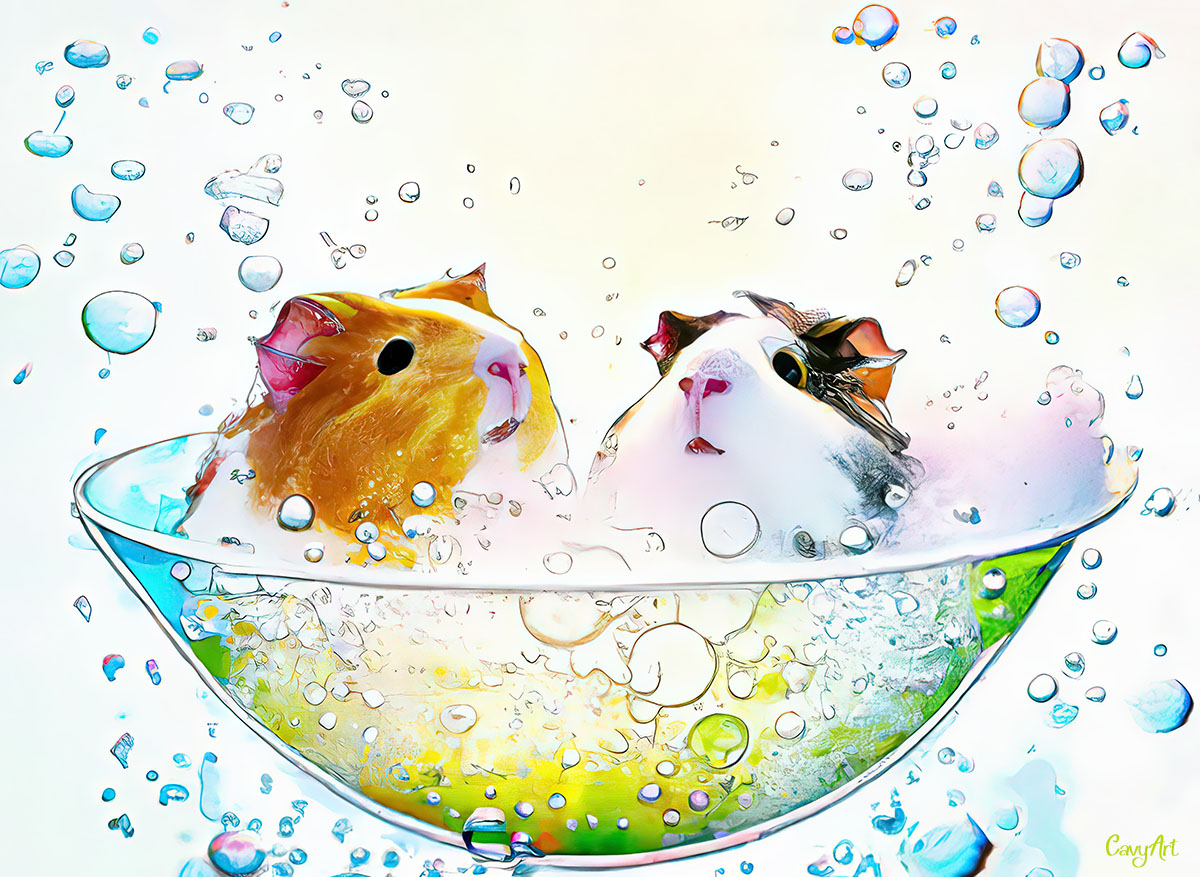 Buddy Baths
Buddy Baths
You can try giving your pigs a bath together, or one right after the other. Shared trauma is a bonding experience. They get clean and benefit from some scent reduction for a while.- Boar scent cleanup
Cleaning the scent gland might help with taming the crazies. Scent is used in multiple ways in the animal kingdom, and certainly is involved in boars’ struggles to assert dominance. In addition to or instead of the buddy bath, try making sure the scent gland is clean. It's located right where their tail would be. It can get mega sticky and oily. It needs to be kept clean in general. I use coconut oil and a very soft bristle toothbrush to gently work it clean if necessary. You rub in a small amount of coconut oil and let sit for a while. Work it clean with a soft toothbrush and rinse and dry. - Boardom Busters
Perhaps your pigs need more distractions. Add some chew toys. Add a mirror. Stuff a paper bag full of hay and put that in the cage. Change up the hideys. Add more hideys. Whatever you can think of that might offer more enrichment for them. It's a long shot, really, but worth a try. - Neutering one or both males
Keep in mind this rarely works to curb boar aggression. Odds are high they will still bicker and fight. but over time, it can reduce some aggression, or so I've heard. In my years of experience, this just has not helped to keep the peace. Surgery is always a life risk, so it's generally best not to consider this option. Usually, neutering should only be undertaken to prevent pregnancy. But there are circumstances where it makes sense. If you also have another female guinea pig (or more) in your herd and you have 3 males who are fighting, and you have a great vet with guinea pig neuter experience and can afford the typically very high price tag ($500-$1000 these days), then getting a male neutered to put in with the females can be a good way to go. Keep in mind, it's ONE AND ONLY ONE male per female or group of females. More than one neutered male WILL fight over the females. So, just one neutered male per female group. - IF your cage is big enough, a temporary separation
Honestly, I really don't recommend doing this very often. Generally speaking, it's better to leave them to sort things out. The vast majority of people separate them unnecessarily or too soon. Every time you separate them, you really need to go through the whole dating game/introduction process all over again, because they are still accustomed to independent living and the hierarchy is still in flux.
After a temporary time-out, you can't just say, okay, let's see how it goes this time and just put them in together, and hope for the best. Follow the protocol and do proper introductions all over again to have a hope for peace.
When separation is necessary
If you know it's going to be permanent rather than temporary, you must ensure that each pig has at least a 2x3 grid size of main-level space available to them. You cannot permanently divide a large 2x4 cage. A 2x2 grid area is just too small for any pig, inhumanely so. If it's truly very temporary (measured in days, not weeks or months), then if you must compromise on space, you have to do what you have to do.
- Add a divider
Add a Wall of Silence-style cage divider as noted above.
- Add an extension
Bump up your Cagetopia C&C cage to a Jumbo so that you can both give them more room AND leave yourself the option to humanely divide the cage. Our extension kits let you add-on to your existing Coroplast base along with the right number of grids and connectors. - Add an upper level
This can help a lot if you don't already have a loft or patio or Lookout Lounge. But, make sure your choice includes a double ramp, which means the Loop Lofts (two ramps) and Porch Patios and Lookout Lounges. For males, a wide loft would be better, but a Narrow Loop Loft is better than no loft at all. Adding an upper level helps them burn off more energy, leaving less to spend pestering their cage mate and they provide other health benefits as well. - Stack a second cage
This is usually what many folks want to do because of space limitations in the home. But, this is NOT desirable. Most importantly, the pigs are now visually separated. While they can still hear and smell the other, it's definitely not as social of an experience for them. It's much more isolating. It's far, far better to have them next to each other if possible. And then, there is the toll it will take on you. Regardless of how some people brush aside the extra level of effort needed to maintain stacked cages, it's absolutely more work. If at all possible, do not stack cages! Please don't do it if you can avoid it. The reaching required by you for cleaning and feeding is more involved. Light and airflow tends to be compromised for at least one group.
But, if you must, we have multiple approaches for you to review and consider. Here are our creative cages that are stacked in some way. Also, be sure to read this entire article about the details to consider when you want to stack cages. - Last but not least, rehome.
You should almost always be able to pair up a male with another male. You may need to work with a responsible rescue to help you find and pair up your male with a good partner. But, on the flip-side, please don't even think about "giving" or "donating" your pig to a rescue. Rescues do not "want" your guinea pigs. We take them in because we are committed to saving lives and quality of lives. Rescues are always full and then some, and usually pull from shelters first. It would be best if you found a responsible home on your own. Maybe your "odd man out," so to speak, will be a perfect fit for another male. Use www.GuineaPigFinder.com to list your male for adoption if you need to.
Know your limits. Life happens and we do what we have to do and sometimes we have to make hard decisions. Do what's right for all parties. :) - Retry introductions every so often
You'll need to be the judge of when and if, but every six months or so on permanent separations can be worth doing. - Floor time?
Also, see if they can at least get some floor-time together for socializing. Perhaps they can't live in the same cage, but will be okay on visits instead.
Find a Path to Peace
It's possible with patience and perseverance. Reach out to a rescue if there is one in your general area or online for additional guidance and support.
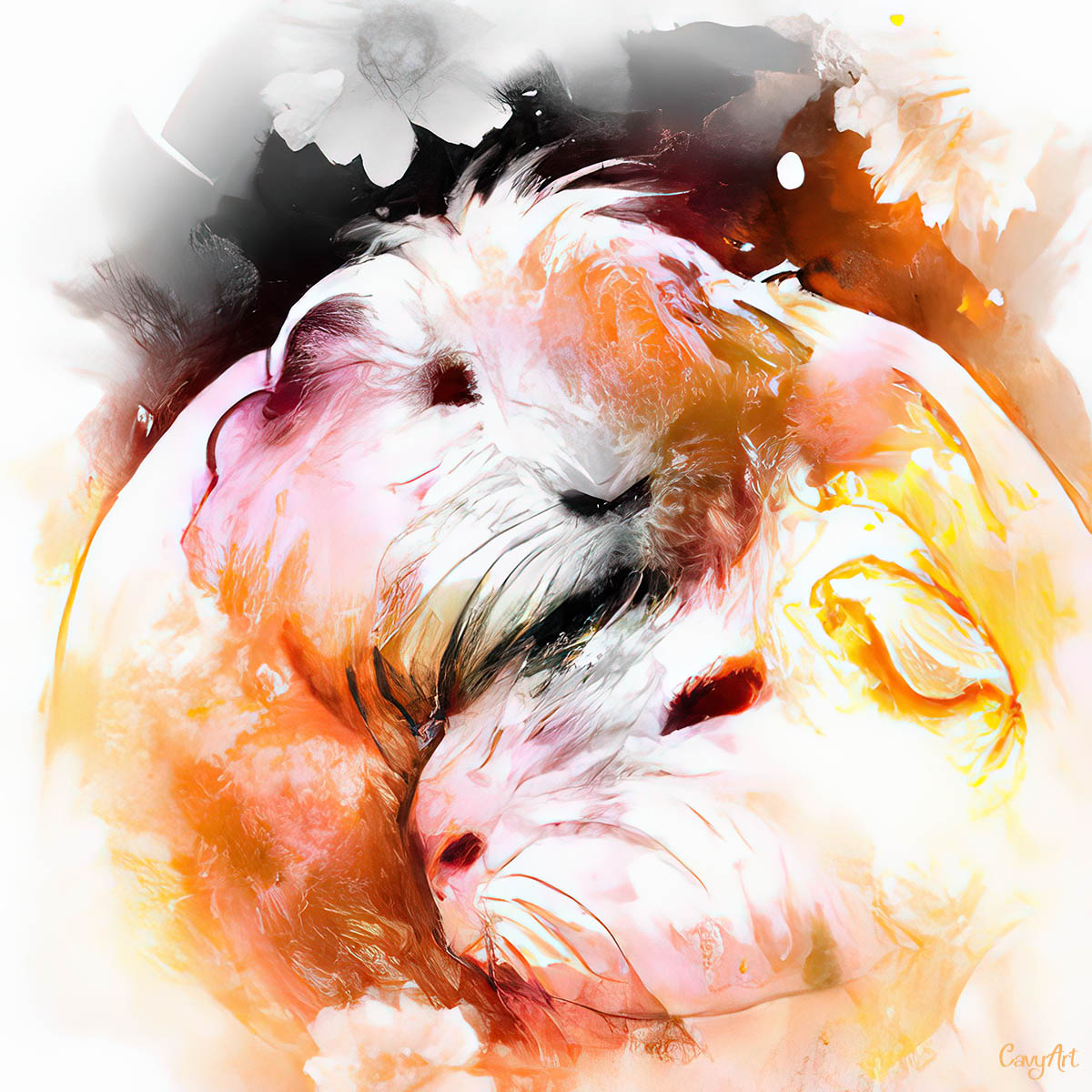
Side Bar Story
Back in my early days of rescue when I still had my very first guinea pig that started it all, Babe, I was learning a lot about social hierarchy and behaviors.
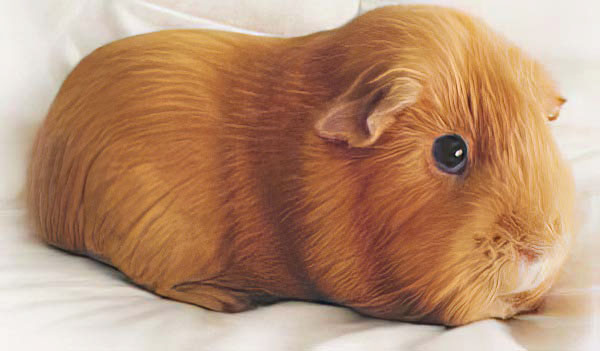
Babe, was an overweight, spoiled sow that started it all for me. I inherited Babe from a boyfriend who only fed her carrots. Oh my. Needless to say, not only was she overweight, but she had diabetes and cataracts as well from too much sugar in her diet. She was the queen pig. All the other pigs that I brought in from my first wave of rescues from our local shelter deferred to her.
I had a handful of pigs that I decided to take outside for a little fresh air on my stone patio with a secure, completely enclosed backyard. My feisty male, Ralphy, decided he needed more adventure and got out of the corralled area, and found great delight in running back and forth along the solid wall of the backyard fence (small, suburban home with small backyard).
It was time to go in, but every time I got in his way and went to pick him up, he managed to leap over my hands and continued his running game. I suppose I could have tried harder, but it was pretty funny actually.
Then I thought, hmmm, let me go get Babe. So, I got Babe and plunked her down directly in Ralphy's path on his return trip. Immediate brakes!! He came to a dead stop and turned around and ran the other way. He did not try to leap over or run around her. Not at all. Nope. She was like a brick wall. But, I still couldn't quite catch him.
So, I kept picking her up and plopping her down to continually shorten his run distance until he finally gave up and I was able to pick him up easily without drama. LOL